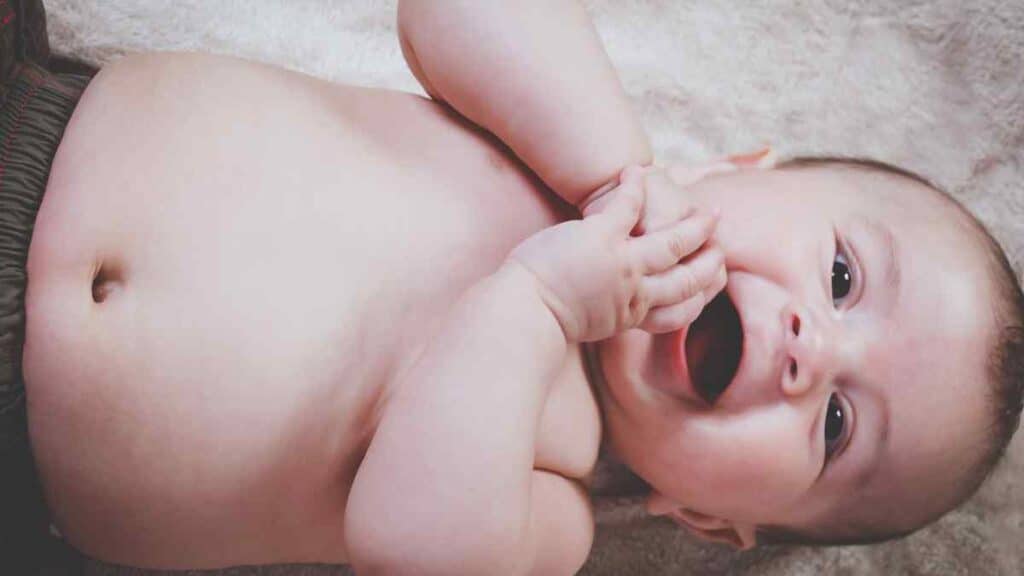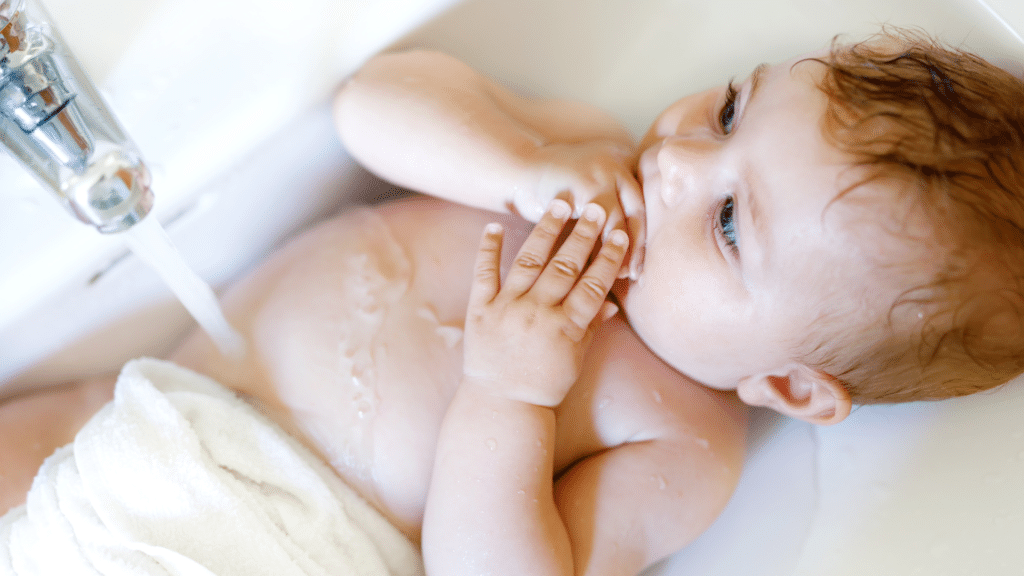Baby massage utilizes a gentle and nurturing technique involving the systematic stroking of a baby’s body. Far beyond a simple method of care, baby massage fosters a unique form of communication and connection, contributing positively to a baby’s physical and emotional growth.
In this blog, we dive deep into the profound philosophy embedded within baby massage. We discuss it not merely as a routine care task, but rather, as an integral opportunity for enhancing the bond between parents and babies.

Understanding the Art of Baby Massage
Baby massage, a rhythmic stroking of a baby’s body, is deeply rooted in history and culture, from India to Africa, emphasizing the importance of touch. It enhances the infant’s sense of touch, balance, and body awareness. It pays particular attention to the baby’s belly and baby’s tummy, vital areas for digestion and general well-being.
More than a routine care task, baby massage is a valuable bonding tool between parents and babies. It becomes a language of love, security, and comfort for babies. This nurturing practice, when consistent and mindful, helps in laying a foundation for lifelong love, trust, and secure attachment.
The Science Behind Baby Massage
While the art of baby massage might be deep-rooted in human culture and tradition, its significant benefits are also scientifically documented. Multiple studies highlight the physical and psychological advantages of a regular massage routine for infants, especially when performed by a parent.
Research indicates that massaging a baby, focusing particularly on areas such as the baby’s arms and belly, promotes weight gain and a healthy pace of growth, thanks to the stimulation of the baby’s digestive and circulatory systems.
This enables improved nutrient absorption and overall physical development. Using a suitable massage oil can further enhance these benefits, by moisturizing and nourishing the baby’s skin.
For preterm infants, daily massage sessions boost faster weight gain and superior neurological progression. This emphasizes the striking influence of stimulating touch on a developing baby.
Baby massage also positively affects an infant’s sleep cycle, as documented by the Journal of Perinatal Education. Appropriate sleep is crucial for an infant’s all-round growth and development.
The release of oxytocin, a hormone linked to bonding and stress relief, during massages underlines the mental development benefits. This hormone is produced not only in the baby but also in the parent performing it, fostering a stronger emotional bond.
Indeed, the science behind the massage technique affirms the benefits of baby massage, making it a valuable pursuit. It contributes to a nurturing environment and endorses a scientifically endorsed method that boosts the overall development of infants, both physically and emotionally.
The Advantages of Baby Massage
The ritual of baby massage carries myriad benefits, creating harmony between traditional wisdom and modern science. These can be broadly categorized as emotional and physical advantages:
Emotional Benefits
- Quality Time: The one-on-one interaction during the massage provides undisturbed, quality time between parent and baby, fostering unique bonds.
- Bonding: The physical touch, rhythmic strokes, and eye-contact during massage sessions build strong emotional bonds and secure attachment.
- Understanding Your Baby: Massages allow parents to understand their baby’s unique needs and responses, leading towards better parenting skills.

Physical Benefits
- Improved Digestion: Gently massaging the baby’s abdomen supports digestion. It can relieve discomfort from gas and colic, and stimulate healthy bowel movements.
- Better Sleep Patterns: By helping babies relax, massages can induce more restful sleep, and potentially help regulate the baby’s sleep cycle.
- Improved Body Awareness: The rhythmic strokes across different parts of the baby’s body can boost their sense of self and body awareness.
- Overall Wellbeing: Regular massages improve circulation and relaxation, leading to longer sleep durations, reduced discomfort, and improved breathing patterns.
From personal experience, baby massage has been a vital part of my motherhood journey:
- Building Trust: Eye contact during massage sessions instilled growing recognition and trust.
- Creating Memories: Each massage session became an unforgettable memory, a unique connection.
- Peaceful Sleeps: The calming effect of massages often culminated in uninterrupted slumber.
Baby massage, thus, advances beyond being a routine task. It combines love, care, science, and culture to enhance emotional bonds and promote physical growth in a uniquely gentle and nurturing manner.
Baby Massage Techniques
For those unfamiliar, giving a baby massage might seem intimidating. However, with the right approach, it becomes a calming and comforting experience for both parent and baby. Here is a simple, step-by-step guide to help initiate this beautiful process:
Creating a Soothing Environment
Start by building a comforting atmosphere:
- Find a warm, quiet room to minimize distractions.
- Lay your baby on a soft, safe surface, like a changing mat or a soft blanket.
- Ensure your hands are clean and warm.
- Apply baby-friendly oil (after a patch test for allergies) to enhance the massage.
- Consider playing soft music for a peaceful ambience.
Basic Baby Massage Steps
- Feet First: Babies often enjoy a foot massage. Start by encircling one foot with your hand. Stroke from heel to toes, then gently squeeze each toe.
- Legs Next: Stroke from ankle to thigh on the leg. With hands clasped around your baby’s thigh, act as though gently milking.
- Hand to Arms: Replicate the process used on the legs, moving from hand to shoulder. Open their hand by stroking the palm, and gently rotate the wrists and elbows.
- Chest and Tummy Time: From the center outward, stroke your baby’s chest. Surround the navel with your fingers in a clockwise direction on the tummy, which can support digestion.
- Back Massage: With your baby facing down, stroke from neck to feet, ensuring to avoid direct pressure on the spine. A few times would be sufficient.
- Focus on Each Body Part: Be conscious of each body part attended to during the massage, ensuring they receive ample attention.

Safety Considerations and Guidelines
- Gentle Pressure: Apply firm but gentle pressure. The massage should never cause discomfort.
- Maintain Eye Contact: Keeping eye contact can strengthen bonding during the massage.
- Observe Your Baby: Stay in tune with your baby’s reactions throughout the massage. Stop if they seem unhappy or distressed.
- Avoid When Ill: Never massage your baby when they’re unwell or just after vaccination.
- Meal Times: Avoid massages directly after a feed or when the baby is hungry.
- Lung Health: Focusing on the chest area may help the baby develop improved breathing patterns.
The goal here lies in balancing relaxation and stimulation. Use this guide as a starting point, but adapt it to your baby’s unique needs and responses. Cherish this serene journey of bonding and nurture.
Baby Massage for Special Situations
Every child possesses their unique needs and faces their individual challenges. Babies with specific health concerns or special needs often benefit from additional comfort and support methods. In such cases, baby massage can be a tailor-fit solution.
Baby Massage for Babies with Special Needs
Babies with special needs often react positively to tactile stimulation. Conditions like Autism or Down Syndrome may witness symptom relief through regular massage sessions. These sessions can help develop muscle tone, coordination, and sensory integration, promoting relaxation alongside.
AnecdoteI recall a parent attending my workshop who had a child diagnosed with Down Syndrome. After incorporating massage into their daily routine for two months, they found their child to be more relaxed and sleeping better, exhibiting noticeable improvement in muscle tone.
Baby Massage for Babies with Health Concerns
Colic: Expert opinions suggest regular tummy massages can alleviate discomfort associated with colic. Gentle, clockwise strokes around the belly button can encourage bowel movement and assist in releasing trapped gas.
Anecdote: A couple I assisted were eager to soothe their colicky baby and embarked on regular tummy massages. After a few times over several weeks, they noticed a significant reduction in their baby’s distressing episodes—resulting in a happier baby and less stressed parents.
Preterm Babies: Massage therapy boasts substantial benefits for preterm babies, leading to improved weight gain and robust neurodevelopmental functioning.
Expert Opinion: Dr. Tiffany Field, director of the Touch Research Institute at the University of Miami, concluded in her research that preterm babies receiving massages gained nearly 50% more weight and left the hospital six days earlier than those that did not receive massages.

Proceeding with Care
When massaging babies with special circumstances, it’s always crucial to proceed with extra care and likely under the supervision of a healthcare provider. It might be helpful to consult with a professional fully trained in infant massage to learn the correct techniques.
In these special situations, baby massage can become more than routine but a therapeutic tool, enhancing the child’s wellbeing, contributing to his or her developmental milestones and fostering stronger parent-infant bonding. But as always, the baby’s comfort and safety should lead the way.
Precautions and Tips for Baby Massage
In this section, we will look at some important precautions and tips that you should keep in mind while massaging your baby. Not only will these help ensure a safe and enjoyable experience for both you and your baby, but they will also optimize the benefits received from the baby massage.
Precautions
- Allergy Alert: Before applying any oil or lotion on your baby’s skin, make sure to do a patch test to check for allergies. Apply a small amount on the back of your baby’s hand or leg, and wait for 24 hours to observe any adverse reactions such as redness, irritation, or rashes.
- Medical Conditions: If your baby has any medical condition or skin problem (e.g., eczema, broken skin, or a rash), consult your healthcare provider before starting the baby massage.
- Temperature Check: Ensure the room temperature is warm enough before starting the massage. A cold environment can result in discomfort and undue stress for the baby.
- Timing: Plan the massage session when your baby is awake but calm. Avoid times when the baby is fussing, crying, or showing signs of hunger or sleepiness.
- Growth Spurts: During growth spurts, your baby might be more sensitive and irritable. It is best to shorten the massage duration or postpone it to a later time if your baby seems uncomfortable.
Tips
- Establish a Routine: To maximize the benefits of baby massage, try to establish a daily routine. This will allow your baby to familiarize themselves with the process, feel more relaxed, and better anticipate the massage sessions.
- Be Attuned to Your Baby’s Mood: Always be mindful of your baby’s mood and signals. If your baby seems uncomfortable, uninterested, or agitated, it’s best to stop the massage and try again at a later time.
- Relax Yourself: Your baby can perceive your emotional state, so it’s important that you feel relaxed and calm. Take a few deep breaths and clear your mind before starting the baby massage.
- Gradually Increase Massage Time: Start with a short, gentle massage, and progressively increase the duration as your baby gets accustomed to it. This will build a positive association with the massage, making the baby feel more comfortable.
- Pressure Matters: Use gentle pressure during the massage, akin to how you would massage your own eyelids. Remember, the baby’s skin is delicate, so press gently for a comfortable and soothing experience.
- Keep the Massage Simple: Focus on basic strokes and techniques to avoid overwhelming your baby. As your baby becomes more familiar with the massage, you can introduce new strokes and techniques.
- Talk to Your Baby: Talk, sing, or hum to your baby during the massage. This helps create a comforting atmosphere and strengthens your bond.
- Practicing Patience: It may take a few attempts for you and your baby to get used to the massage process. Be patient, and understand that it takes time to build a trusting relationship and make the baby feel comfortable.
By following these precautions and tips, you can ensure a safe and enjoyable baby massage experience for you and your little one. This will enable you both to reap the numerous physical and emotional benefits of baby massage, ultimately leading to a stronger parent-baby bond and a healthier, happier baby.

Conclusion
In conclusion, baby massage is a potent and time-honored practice with various benefits for both infants and parents. Far from being a simple care task, it’s a gentle yet profound art that transcends cultural boundaries and is backed by modern science. Baby massage not only supports healthy physical and emotional development but also fosters a unique dialogue of love, trust, and connection between parents and their babies.
This blog aimed to provide readers with a comprehensive understanding of the art of massaging your baby, interpreting its rich history and philosophy, the robust scientific evidence supporting its benefits, and its numerous emotional and physical advantages. Moreover, we have offered easy-to-follow techniques and guidelines on how to massage a baby for a successful and nurturing experience. This artful practice provides parents and caregivers an opportunity to fortify bonds, promote their children’s overall well-being, and partake in a beautiful, nurturing ritual that spans across generations and cultures.
Did this article help you? Please let me know down below, and if you have any questions, don’t hesitate to ask.



